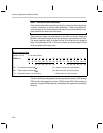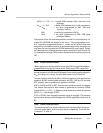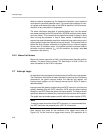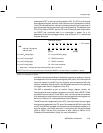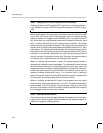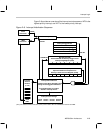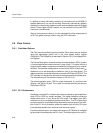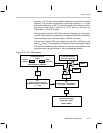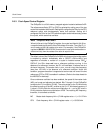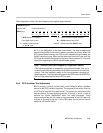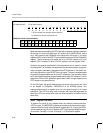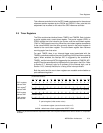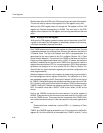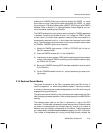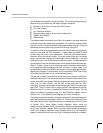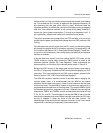
Clock Control
2-28
2.8.3 Clock Speed Control Register
The ClkSpdCtrl is a 16-bit memory mapped register located at address 0x3D.
The reference oscillator (RTO or CRO) is selected by setting one of the two
control bits located at bits 8 and 9. Setting bit 8 configures the C6xx for the RTO
reference option and simultaneously starts that oscillator. Setting bit 9
configures the C6xx for the CRO reference option and simultaneously pulses
the crystal, which starts that oscillator.
Note: ClkSpdCtrl Bits 8 and 9
When bit 8 is set in the ClkSpdCtrl register, the crystal oscillator bit (bit 9) be-
comes the least significant bit of the 6-bit resistor trim value. Thus, bits 15–11
and 9 make up the 6-bit resistor trim value. For example, if the ClkSpdCtrl
register is 00010X11XXXXXXXX (X means don’t care, bold numbers are re-
sistor trim bits), then the resistor trim value is equal to five.
The default value of the ClkSpdCtrl is 0x0000, which means that neither option
is enabled by default. Immediately after a RESET LOW-to-HIGH, and
regardless of whether a resistor or a crystal is installed across OSC
IN
/
OSC
OUT
, the C6xx does not have a reference oscillator running. In the
absence of a reference, however, the PLL still oscillates; it bottoms-out at a
minimum frequency. The master clock, in turn, runs at a very slow frequency
(less than 100 kHz) in the absence of a reference oscillator. Under this
condition, program execution is supported at a slow rate until one of the two
references (RTO or CRO) is enabled in software. (Refer to the data sheets for
the MSP50Cxx devices).
Once a reference oscillator has been enabled, the speed of the master clock
(MC) can be set and adjusted, as desired. Bits 7 through 0 in the ClkSpdCtrl
constitute the PLL multiplier (PLLM). The value written to the PLLM controls
the effective scaling of the MC, relative to the 131.07 kHz base frequency. A
0 value in PLLM yields the minimum multiplication of 1, and a 255 value in
PLLM yields the maximum multiplication of 256. The resulting MC frequency,
therefore, is controlled as follows:
MC Master clock frequency kHz = (PLLM register value + 1) × 131.07 kHz
CPU Clock frequency kHz = (PLLM register value + 1) × 65.536 kHz



